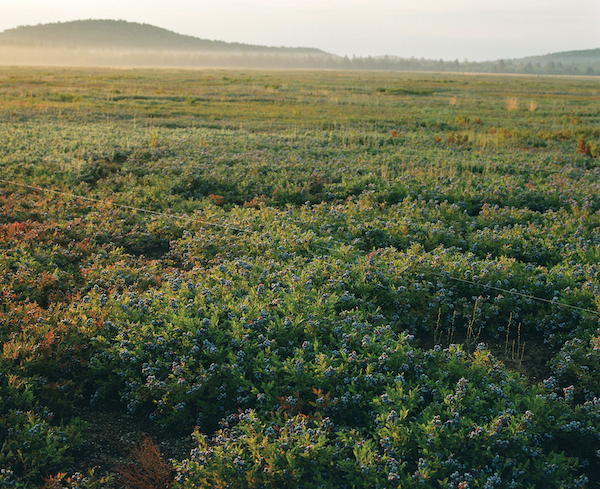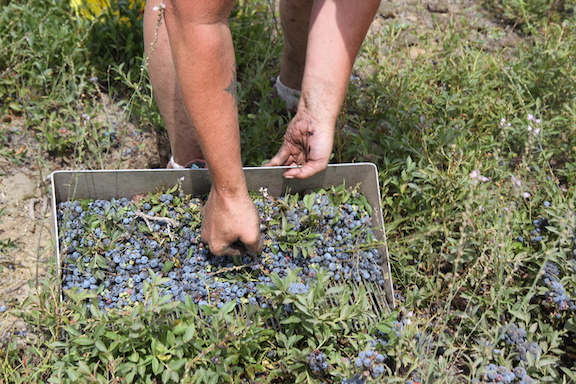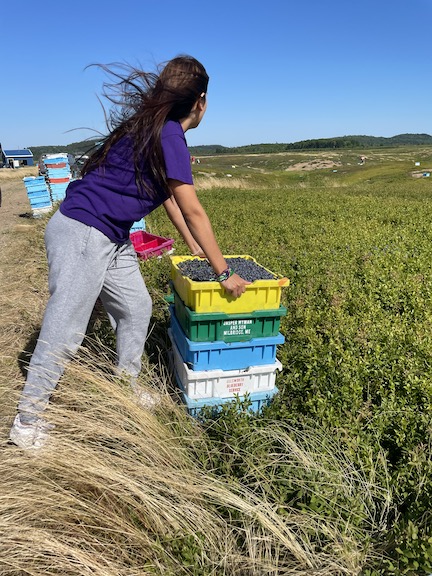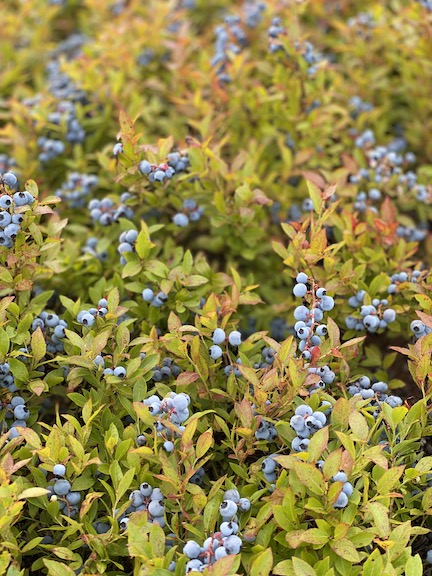The Wild Blueberry Heritage Center is housed in an iconic bright blue dome on Route 1 in Columbia Falls, Maine. On its website, the center calls on its users to take a pledge. The pledge reads: “I pledge to always Use the word WILD whenever I reference the ‘WILD’ Maine low bush blueberry.” It’s the center’s nudge for blueberry consumers to acknowledge the differences between Maine’s lowbush blueberries (botanically speaking, Vaccinium angustifolium) and highbush blueberries (Vaccinium corymbosum).
The Passamaquoddy Wild Blueberry Company (PWBC), also located in Columbia Falls, appreciates the center’s efforts to distinguish Maine’s petite wild blueberries from their large highbush cousins. Darren Paul, general manager at PWBC and member of the Passamaquoddy Tribe says, “I’ll eat the big ones, but they don’t taste the same. I mean, they look good, but they’re not as sweet.”

Roughly 25,000 years ago, a mile-thick layer of ice covering the entire area of what is now called Maine began to retreat and melt. Over the next 13,000 years, the power and tumult of ice and water carved Maine into its current landscape. As the glacier scraped across the land, large boulders were ground into smaller stones, gravel and sand. The glacier pushed this debris, aided by melting water beneath the glacier, into a hilly rock-strewn landscape. These hills of well-drained sandy soil, now referred to as the barrens, are primarily located in Maine’s eastern counties: Washington, Hancock, Knox and Waldo.
Slowly, the opportunistic and tenacious wild blueberry plant, able to survive in these thin, acidic glacial soils began to spread through the barrens. The People of the Dawn, or the Wabanaki, were among the first people to harvest the wild blueberries, which they used fresh and dried as a food, medicine and dye. The Wabanaki were also the first to nurture the crop through the use of controlled burning, a practice later employed by the colonists who arrived in the region in the 1600s. The commercial harvest of the crop, however, didn’t really begin until the Civil War when the Union Army, in desperate need of vitamins and nutrients for its soldiers fighting in the south, purchased large quantities of berries canned in one of Maine’s many factories.
Wound through the history of the wild blueberry is a story of the oppression and genocide of the Wabanaki (the Maliseet, Micmac, Passamaquoddy, Penobscot and Abenaki). Wabanaki REACH, a nonprofit that supports the self-determination of Wabanaki people through education, truth-telling, restorative justice and restorative practices in Wabanaki and Maine communities, summarizes the history of colonization in a 2016 blog post: “Since first being targeted for destruction by Europeans during the 15th century, Wabanaki people have suffered a 96% population depletion due to disease, land dispossession and forced removal, decimation of traditions through Christian conversion, warfare between Europeans, and scalp bounties.”
The Passamaquoddy Tribe, by the mid-1830s, had been deprived of almost all of its territory except for Sipayik (Pleasant Point Reservation) — a 100-acre block of land along Passamaquoddy Bay — and Motahkomikuk (Indian Township Reservation) — a large parcel of woodland on the west branch of the St. Croix River. Despite this theft of their ancestral lands, the Wabanaki, including Canadian Mi’kmaq, remained connected to the landscape and, by the 1960s, provided most of the harvest labor in the blueberry barrens. In this era, before the widespread use of mechanical harvesting, thousands of Wabanaki tribal members (and many others) flocked to the barrens for a month-long intensive raking rendezvous, often living in small camps provided by the farm owners. Rakers stretched across the landscape, each in a lane created by thin cotton string, pulling their rakes, like dust pans with little teeth, through the sea of blue.
Given their innate knowledge of the landscape, the plants and the harvest, the Passamaquoddy Tribe decided to purchase the Northeastern Blueberry Company with a share of their settlement from the Indian Land Claims Settlement Act of 1980. The purchase amounted to 2,000 acres of barrens in Columbia Falls, Columbia, Centerville and Township 19. The tribe decided that 100% of the company’s profits were to be reinvested in future growth or distributed to the Passamaquoddy Tribe.
The company was rebranded from the Northeastern Blueberry Company to PWBC in 2013. Since its inception, the business has managed to stay true to its mission to provide economic opportunity for the Passamaquoddy Tribe and honor their cultural connection with the wild blueberry while also making pivots to stay economically viable in what can be a volatile commodity market.
Wild blueberries are grown on a two-year production cycle — a prune year and a crop year. This means that PWBC harvests berries from half their land (1,000 acres) each year. In the fall, ideally after a hard frost, Paul or one of the eight full-time year-round employees, runs a flail mower over the ground that was harvested the previous summer. Mowing, according to Paul, mimics burning and is cheaper, since modern burning methods require diesel fuel. The entire following year is a vegetative year where stems, leaves and buds develop.
There’s a lot of field work for what eventually culminates in an intensive one-month harvest when dozens of extra people join the PWBC staff to pick and transport the berries to two processing facilities. PWBC is actually the largest wild blueberry company in Maine without its own processing facility. Wild blueberries are thin-skinned and tender and need to be flash frozen before they can make their way to grocery stores or into other products. To eat fresh wild blueberries is unique; nearly all of the 105 million pounds harvested on 500 farms in Maine during the 2022 season were flash frozen.
Though field management and processing of PWBC berries are standard to the industry, one element of PWBC’s approach is not. PWBC prides itself on its continued use of hand raking, which stands in contrast to some wild blueberry growers who have entirely mechanized the harvest process. Prior to the COVID pandemic, about 20% of PWBC’s berries were hand-harvested.

“One of our goals is to retain that century old tradition of hand raking and having the community come together to rake these berries and do what their ancestors did,” says Holli Francis, the product manager at PWBC. Her husband and two children are both members of the Passamaquoddy Tribe. Paul says getting people back into the field post-COVID has been difficult, but Francis is confident that families of rakers will once again fill the small camps provided by the company.
While maintaining some degree of hand raking is important to PWBC’s mission, the company also has slowly, acre by acre, been removing the large boulders and smoothing the hummocks left behind by the glacier. They recently purchased a large excavator so they can do the earthwork themselves rather than rely on contractors. Less rocks and level terrain allow for a mechanized harvest, and PWBC owns two of its own blueberry harvesters. These large machines attach to a tractor and use a pickup head that rakes its way through the berries. During the harvest, they also hire two custom harvesters.
Not having enough hand rakers and the whims of Mother Nature at harvest are inherent challenges but, to some extent, they can be hedged by mechanization. Market whims are another. For example, in 2017, the pay price for wild blueberries plummeted to about 50 cents per pound due to an oversupply caused by increasing wild blueberry production in Quebec as well as the increased production of highbush blueberries. For the first time in its history, PWBC didn’t harvest any of its crop because their processor wouldn’t buy it.

Though the company had long dreamed of marketing berries under their own label, this market instability pushed PWBC management — Paul, farm manager J.D. Newell and four board members — to brainstorm new ways to distinguish their berries within the crowded marketplace. They applied for and, in 2020, were granted a $250,000 United States Department of Agriculture (USDA) Value-Added Producer Grant.
This grant allowed PWBC to build a brand, becoming their own storytellers, rather than relying on someone else to tell the wild blueberry story for them. Francis says, “The story of the Wabanaki people harvesting these berries wasn’t being told. Our entire crop was being sold to one processor to use as their own brand.”
In 2021, the first year of selling under their own brand, they sold 500,000 pounds, all in 30-pound boxes. In 2022, they sold one million pounds, mostly through distributors such as Downeast Food Distributors, Favorite Foods, Native Maine Produce and Sysco. After being asked by American Indian Foods (a platform for American Indian food businesses) and the Maine North Atlantic Development Office, some PWBC berries even wound their way to the Arctic Circle 2022 Assembly in Reykjavik, Iceland.
Buyers also include restaurants, breweries, wineries and bakeries. Some of these businesses help to further the reach and the story of the PWBC. For example, Allagash Brewing Company markets a Tripel aged on PWBC berries. One hundred percent of the profits from this beer goes towards nonprofits supporting the Wabanaki people.
Another decision PWBC made after the 2017 debacle was to transition about 30 acres to organic production, a process that takes three years. They’ve since certified another 30 acres, meaning they harvest about 30 acres of organic berries a year. They had their first organic harvests in 2021 and 2022. Year one, they sold the organic crop to Seal the Seasons, a boutique frozen foods company. Year two, the organic crop ended up at Stonewall Kitchen, where it was turned into an organic wild blueberry jam.
Paul’s been the one behind the sometimes tedious paperwork associated with organic certification, and he’s been helping make decisions with the farm manager. He does feel that organic production is more labor intensive. The fields are not as clean as conventional fields, says Paul. “Some of the rakers don’t like raking them. You have to pay differently. The berries are still pretty good. We’re getting a decent crop of them, but it’s not as good a yield as conventional,” he continues. “It is a lot of work, but people want organic berries, and they’re willing to pay a decent price for them.”
The organic blocks are smaller than their conventional fields, mostly because they had to find areas that had an adequate buffer zone from the sprayed conventional fields. Because of the size, Paul doesn’t think it’s worth irrigating the organic crop, which they do with about 70% of their conventional fields. Should irrigation equipment be set up, a percentage of the already smaller-scale organic crop would be sacrificed to the foot traffic required to get water to the plants.
In both their organic and conventional fields, non-irrigated fields are harvested first because the berries tend to be smaller and are prone to drying out. This early harvest is advantageous in organic blueberry production because spotted wing drosophila, an invasive fruit fly species that causes significant economic damage to fruit crops in the United States each year, hasn’t had a chance to infest the crop with its larvae. The early harvest prevents PWBC from having to spray an organic insecticide to manage the pest.

The organic blocks are sprayed with the organic insecticide Entrust to manage for blueberry maggot fly (also a type of fruit fly) larvae, which tend to appear in berries in mid-July. Paul and the crew monitor for the pest using yellow sticky traps at a rate of 30 per acre. The traps are coated with an adhesive and attractive bait. In trapping the adults, they can predict when the larvae will be present in the crop, which in turn helps them time the Entrust application.
Another difference in the organic blocks is that they burn, rather than mow, the fields because, according to Paul, diseases such as mummy berry blight, blossom blight and red leaf disease are spread more readily by the flail mower. The heat of the fire destroys insects and fungal over-wintering structures, leaving fewer organisms to attack the crop the following year. First, PWBC spreads a thin layer of straw over the berries with a PTO-powered bale shredder. Then, they run a PTO-power burner, which ignites the field using diesel as the accelerant.
In 2021, according to USDA’s National Agricultural Statistics Service, Maine wild blueberry producers were paid an average of 76.6 cents per pound. In 2022, PWBC was paid over three times that for their organic berries, and they were also able to capture a higher premium for the conventional berries they market under their own label.
Whether it’s organic or conventional, a field can have as many as 1,500 genetically distinct wild blueberry plants, creating a tapestry of berry flavors, shapes and colors. In the fall, the explosion of colors in the barrens readily competes with the stunning crimsons of sugar maples in peak foliage.
PWBC, the Wild Blueberry Heritage Center and the state of Maine, which held its first ever Wild Blueberry Weekend in 2021, want these little gems in many shades of blue to be recognized as a uniquely Maine product. PWBC is taking the narrative beyond that: to use their own brand to share the history — past and present — of the Passamaquoddy Tribe.
About the author: Sonja Heyck-Merlin is a regular feature writer for The MOF&G. She and her family own and operate an organic farm in Charleston, Maine.
This article was originally published in the fall 2023 issue of The Maine Organic Farmer & Gardener.

